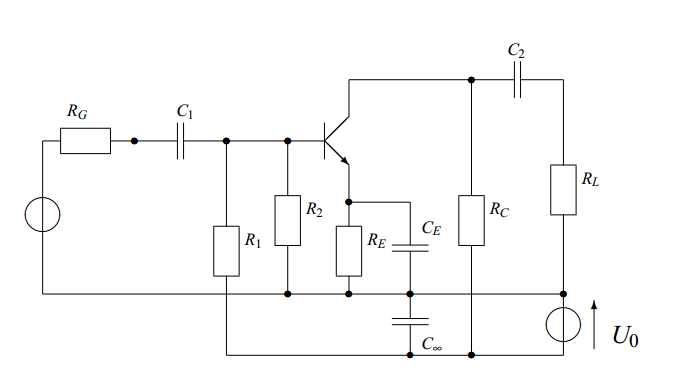this circuit using voltage divider but I don't know why there is \$C_\infty\$ connecting to ground and DC voltage supply. Also, normally, many CE models I have seen don't have \$R_L\$ included to serve as load. Can the variation of \$R_L\$'s value changes the gain?
2 Answers
Your schematic is a weird way of showing the first step of an AC analysis. The original DC version should like this:

simulate this circuit – Schematic created using CircuitLab
For AC analysis, you're supposed to deactivate any DC sources. Voltage sources become short circuits, and current sources become open circuits. Your schematic shows this with an infinite capacitance shorting out U0. Everything connected to U0 was moved to the bottom of the schematic, probably because they will later be shown connecting directly to ground.
C1 and C2 are DC-blocking capacitors, and CE is an emitter bypass capacitor. These will be large enough to act as short circuits at the VG frequency. Thus, the final AC version will look something like this:

The transistor will be replaced with a small-signal model like the hybrid-pi model or the T model:

The value of RL definitely affects the gain! The output of your amplifier can be simplified to look like a voltage source in series with a resistance. (Just like VG and RG!) The output resistance and RL form a voltage divider, which affects the total gain. Likewise, the input resistance and RG form another voltage divider. In a common emitter amplifier, the input resistance comes from R1, R2, and the transistor base. The output resistance comes from RC and the transistor collector.
-
\$\begingroup\$ Hi, the \$C_\infty\$ is connect from DC source directly to the ground. As I know there'll be no current run through it so what's the point of having it. Can you explain to me how difference the circuit will behave with and without it? Additionally, why AC analysis of amplifier is important? \$\endgroup\$– aukxnCommented Oct 8, 2015 at 2:10
-
\$\begingroup\$ I don't think they meant to have a physical capacitor there. It just shows what happens to the DC voltage source at AC. AC analysis gives you the gain, input impedance, and output impedance of the amplifier, which are the most important things. DC analysis just gives you the bias point. \$\endgroup\$ Commented Oct 8, 2015 at 3:35
The capacitor across Uo the supply voltage that's labled C infinity is just a power supply bypass cap .It should have a low impedence at the lowest frequency of interest.Large values are common here.The output impedence of your amplifier is close to Rc so loading it will affect the output volts unless Rl is very high compared to Rc.

